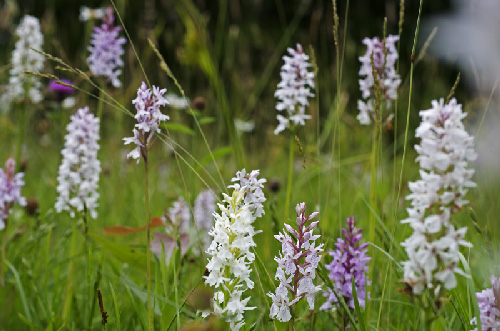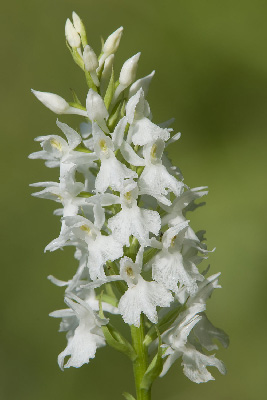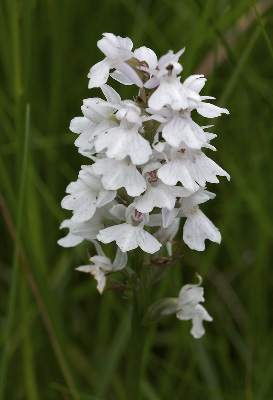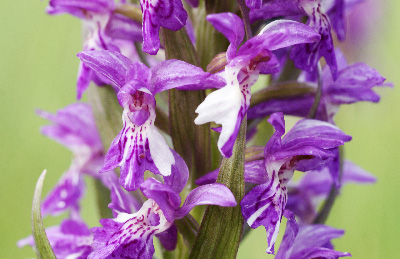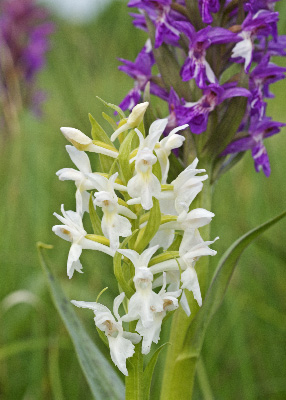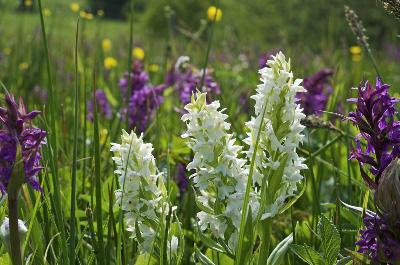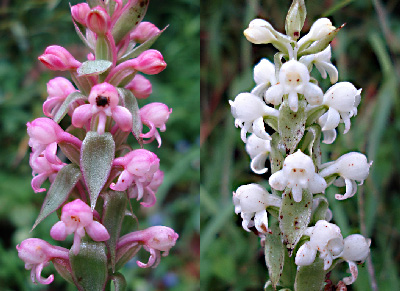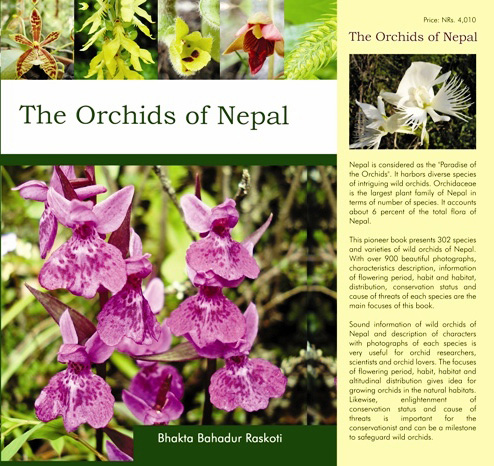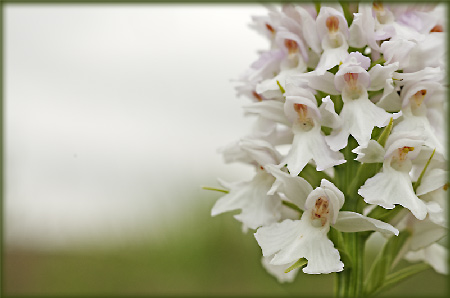
Die Evolution bestimmter Orchideenarten ist alles andere als abgeschlossen. Der Burren, eine Region in der Grafschaft Clare an der Westküste von Irland, belegt dies mit mannigfachen Farbvarietäten von Dactylorhiza fuchsii, dem Fuchs-Knabenkraut. In einer 1988 vorgelegten Studie kamen R.M. Bateman und I. Denholm zu dem Ergebnis, dass die Bestände von Dactylorhiza fuchsii im Burren häufiger einen Mangel am Purpur-Farbpigment Anthocyanin aufweisen als Pflanzen in anderen Regionen der Britischen Inseln:
| Anteil (in Prozent) von Dactylorhiza fuchsii ohne |
im Burren |
in anderen Regionen |
| gefleckte Blätter |
43 |
13 |
| Lippenzeichnung |
48 |
15 |
| Anthocyanin in der Lippe |
48 |
12 |
| Anthocyanine in der Blüte |
35 |
8 |
| Anthocyanine in Blüte, Stängel, Blättern oder Tragblättern |
25 |
6 |
(Quelle: R.M. Bateman/I. Denholm: A reappraisal of the British and Irish dactylorchids, 3. The spotted-orchids. In: Watsonia 17 (1988), S.332)
Bei der Erkundung des faszinierenden Gebiets am Lough Gealain und am Berg Mullaghmore sind diese Ergebnisse durchaus nachvollziehbar. Auch in anderen Gebieten gibt es viele Pflanzen mit hellen oder weißen Blüten, oft nur noch mit dem Pigment für die Lippenzeichnung. Auf einer begrenzten Fläche von 40 Quadratmetern im Gebiet von Rockforest, nordöstlich von Corrofin, habe ich 50 blühende Dactylorhiza fuchsii (neben 7 mit Knospen) gezählt, die folgende Merkmale aufwiesen:
| Dactylorhiza fuchsii mit |
|
| dunkelvioletten Blüten |
0 |
| mittelvioletten Blüten |
11 |
| hellvioletten Blüten |
17 |
| weißen Blüten und gestrichelter Lippenzeichnung |
3 |
| weißen Blüten und gepunkteter Lippenzeichnung |
17 |
| weißen Blüten ohne Lippenzeichnung |
2 |
| insgesamt |
50 |
Zur Begleitflora in diesem Gebiet, mitten in einer ausgedehnten Gegend der für den Burren typischen Kalkplatten (limestone pavement), gehören Orchis mascula, Geranium sanguineum, Rosa pimpinellifolia, Calluna vulgaris, Lotus corniculatus und Pteridium aquilinum.
Das folgende Bild illustriert die breite Variabilität nicht nur bei der Blütenfarbe, sondern auch der Lippenform von Dactylorhiza fuchsii im Burren (einige der Beispiele offenbar mit einem gewissen Einfluss von Dactylorhiza maculata). Es ist deutlich zu sehen, dass die meisten Pflanzen weniger Anthocyanin in den Blüten haben als die kontinentalen Bestände der Art – zum Beispiel die großen Bestände in den Wäldern der südfranzösischen Region Causses mit ihren dunkelvioletten Blüten. Die Pigmente werden zuerst in den Sepalen reduziert, gefolgt von der Grundfarbe der Lippe. Dann wird die Lippenzeichnung reduziert, oft bleibt nur ein kleiner Rest am Eingang der Narbenhöhle erhalten. Aber selbst die sehr weißen Blüten haben noch farbige Pollinien, allerdings ist deren Farbe dann weniger intensiv. Schließlich gibt es auch eine breite Vielfalt von Blütenformen. Vor allem bei dem Mittellappen der Lippe gibt es erhebliche Unterschiede. In einem Extremfall einer weiß blühenden Pflanze waren die Seitenlappen weitgehend zurückgebildet.
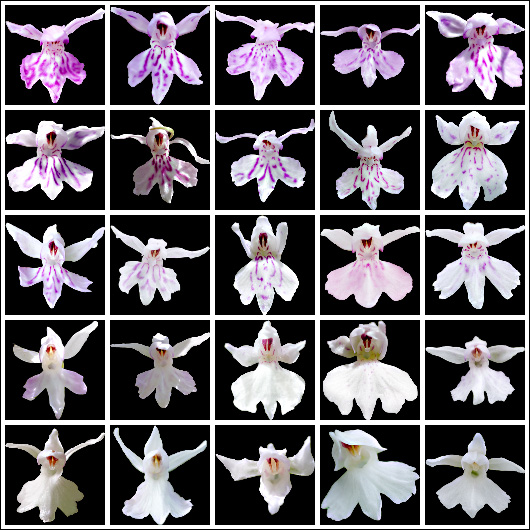
Die meisten irischen und britischen Botaniker betonen, dass Dactylorhiza fuchsii var. okellyi (einige betrachten diese als Subspezies oder gar als Spezies) nicht mit den Albiflora-Formen der Art verwechselt werden darf. Anne und Simon Harrap (Orchids of Britain and Ireland, 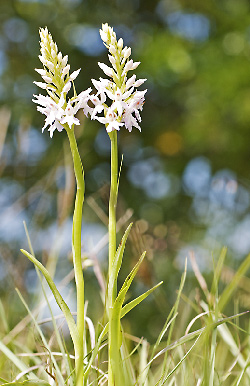 2005) schreiben: „Zu okellyi gibt es viele Diskussionen.“ Sie erklären: „Im Burren und andernorts sind diese klassischen, weiß blühenden okellyi nur Teil einer Population von Pflanzen mit variabler Blütenfarbe.“ Brendan Sayers und Susan Sex (Ireland’s Wild Orchids, 2008) betonen, dass Dactylorhiza fuchsii var. okellyi spät zu blühen beginnt, erst im Juli. Das Foto in ihrem Feldführer zeigt eine Blüte mit einer tief dreiteiligen Lippe. Charles Nelson (Wild Plants of The Burren and the Aran Islands, 2008) gibt an, dass okellyi von Juni bis August blüht und rein weiße Blüten „ohne jede violette Tönung oder Zeichnung“ hat sowie „eine flache Lippe mit drei fast gleich großen, tief eingeschnitten Lappen“. Laut Pierre Delforge (Guide des orchidées d’Europe, 2005), bei dem die Blütezeit von Mai bis Juli angegeben ist, hat die Lippe eine Breite von maximal 8 mm (im Unterschied zu fuchsii mit 8-16 mm). Pat O’Reilly und Sue Parker (Wild Orchids in The Burren, 2007) haben beobachtet, dass „Gruppen von rein weißen Orchideen … eher O’Kellys Knabenkraut sind als einzelne Pflanzen, bei denen es sich einfach nur um sehr blasse Exemplare des Fuchs-Knabenkrauts handeln kann“. Bei der Erkundung der Kalkplattengebiete zwischen Poulsallagh und Rockforest trifft man auf viele weiß blühende Dactylorhiza fuchsii, eher kleinwüchsig und zu Beginn der Blüte mit einem pyramidenförmigen Blütenstand, die den violett blühenden Pflanzen der Art sehr ähnlich sind – sie sollten daher wohl als Albiflora-Formen betrachtet werden. An zwei Orten fand ich jeweils ein Paar von höherwüchsigen Pflanzen, sehr schlank und mit einer eigenständigen Erscheinungsform von Blütenstand wie Blüten, die sich offenbar als Dactylorhiza fuchsii var. okellyii ansprechen lassen.
2005) schreiben: „Zu okellyi gibt es viele Diskussionen.“ Sie erklären: „Im Burren und andernorts sind diese klassischen, weiß blühenden okellyi nur Teil einer Population von Pflanzen mit variabler Blütenfarbe.“ Brendan Sayers und Susan Sex (Ireland’s Wild Orchids, 2008) betonen, dass Dactylorhiza fuchsii var. okellyi spät zu blühen beginnt, erst im Juli. Das Foto in ihrem Feldführer zeigt eine Blüte mit einer tief dreiteiligen Lippe. Charles Nelson (Wild Plants of The Burren and the Aran Islands, 2008) gibt an, dass okellyi von Juni bis August blüht und rein weiße Blüten „ohne jede violette Tönung oder Zeichnung“ hat sowie „eine flache Lippe mit drei fast gleich großen, tief eingeschnitten Lappen“. Laut Pierre Delforge (Guide des orchidées d’Europe, 2005), bei dem die Blütezeit von Mai bis Juli angegeben ist, hat die Lippe eine Breite von maximal 8 mm (im Unterschied zu fuchsii mit 8-16 mm). Pat O’Reilly und Sue Parker (Wild Orchids in The Burren, 2007) haben beobachtet, dass „Gruppen von rein weißen Orchideen … eher O’Kellys Knabenkraut sind als einzelne Pflanzen, bei denen es sich einfach nur um sehr blasse Exemplare des Fuchs-Knabenkrauts handeln kann“. Bei der Erkundung der Kalkplattengebiete zwischen Poulsallagh und Rockforest trifft man auf viele weiß blühende Dactylorhiza fuchsii, eher kleinwüchsig und zu Beginn der Blüte mit einem pyramidenförmigen Blütenstand, die den violett blühenden Pflanzen der Art sehr ähnlich sind – sie sollten daher wohl als Albiflora-Formen betrachtet werden. An zwei Orten fand ich jeweils ein Paar von höherwüchsigen Pflanzen, sehr schlank und mit einer eigenständigen Erscheinungsform von Blütenstand wie Blüten, die sich offenbar als Dactylorhiza fuchsii var. okellyii ansprechen lassen.
Auch Dactylorhiza maculata, das Gefleckte Knabenkraut, tendiert im Burren zu sehr blassen Blüten. Doch die meisten Pflanzen behalten zumindest eine schwache Lippenzeichnung. Offenbar ist die Variabilität von Dactylorhiza maculata (die Pflanzen in Irland werden im Allgemeinen als Dactylorhiza maculata ssp. ericetorum betrachtet) nicht so groß wie die von Dactylorhiza fuchsii. Die relative Häufigkeit von Orchis mascula f. albiflora bewegt sich im gleichen Rahmen wie in Kontinentaleuropa. Unter tausenden von Pflanzen – Orchis mascula ist die häufigste Orchidee der Region – habe ich nur zwei weiß blühende gesehen. Keine einzige Albiflora-Form gab es bei Dactylorhiza incarnata oder Dactylorhiza majalis ssp. occidentalis (auf der Aran-Insel Inisheer).
Verglichen mit der relativen Stabilität der anderen Arten zeigt die breite Variabilität von Dactylorhiza fuchsii im Burren, dass sich diese Art im Zustand eines andauernden Evolutionsprozesses befindet. Es kann nur spekuliert werden, warum Dactylorhiza fuchsii hellere oder gar weiße Blüten bevorzugt – inmitten eines Überflusses von violetten Blütenfarben auf den Wiesen der Region.
 In diesem Jahr konnte ich schon ein paar Tage früher die weiß blühende Cephalanthera rubra im hessischen Teil der Rhön besuchen als im vergangenen Jahr. Zunächst folgte ich aber einem Hinweis auf einen Standort weiter südlich, in der Nähe von Ahlersbach. Direkt am Waldweg stieß ich auf eine weiße Cephalanthera rubra mit einem leichten Hauch von Rosa! In den Knospen ist die Farbe deutlich sichtbar, die erhaltenen Restpigmente sind dort offenbar stärker konzentriert als in der geöffneten Blüte.
In diesem Jahr konnte ich schon ein paar Tage früher die weiß blühende Cephalanthera rubra im hessischen Teil der Rhön besuchen als im vergangenen Jahr. Zunächst folgte ich aber einem Hinweis auf einen Standort weiter südlich, in der Nähe von Ahlersbach. Direkt am Waldweg stieß ich auf eine weiße Cephalanthera rubra mit einem leichten Hauch von Rosa! In den Knospen ist die Farbe deutlich sichtbar, die erhaltenen Restpigmente sind dort offenbar stärker konzentriert als in der geöffneten Blüte. 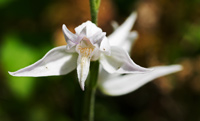 An dem zweiten Standort bei Hünfeld, gut zu erkennen an der alten Buche, die Marco Klueber in seinem großartigen Buch über die „Orchideen in der Rhön“ erwähnt, standen die Albiflora-Pflanzen von Cephalanthera rubra Ende Juni in schönster Blüte. Der schwedische Botaniker L. Anders Nilsson hat (in einem 1984 erschienenen Artikel in der Zeitschrift Nature) gezeigt, dass Cephalanthera rubra die Blütenfarbe der Glockenblume (Campanula) im visuellen System der Bienen nachahmt, um so von ihnen befruchtet zu werden, besonders von den männlichen Bienen der Gattung Chelostoma. Da Cephalanthera rubra vor Campanula blüht, sind sie für die Bienen durchaus von Interesse. Es wäre interessant zu sehen, wie die Bienen auf die Albiflora-Formen von Cephalanthera rubra reagieren.
An dem zweiten Standort bei Hünfeld, gut zu erkennen an der alten Buche, die Marco Klueber in seinem großartigen Buch über die „Orchideen in der Rhön“ erwähnt, standen die Albiflora-Pflanzen von Cephalanthera rubra Ende Juni in schönster Blüte. Der schwedische Botaniker L. Anders Nilsson hat (in einem 1984 erschienenen Artikel in der Zeitschrift Nature) gezeigt, dass Cephalanthera rubra die Blütenfarbe der Glockenblume (Campanula) im visuellen System der Bienen nachahmt, um so von ihnen befruchtet zu werden, besonders von den männlichen Bienen der Gattung Chelostoma. Da Cephalanthera rubra vor Campanula blüht, sind sie für die Bienen durchaus von Interesse. Es wäre interessant zu sehen, wie die Bienen auf die Albiflora-Formen von Cephalanthera rubra reagieren. 
